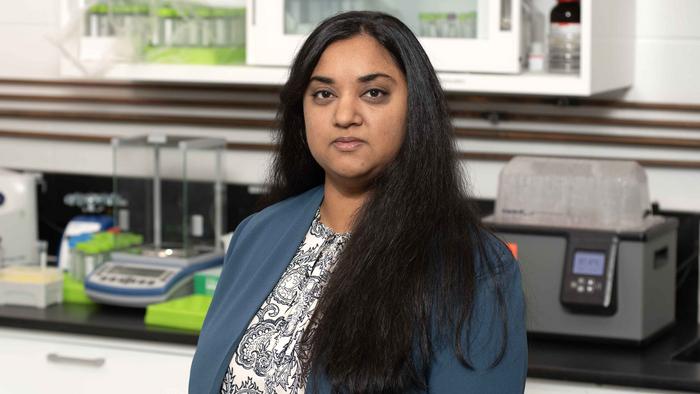
Cancer therapies show promise in combating tuberculosis
EMBARGOED UNTIL MARCH 25, 2024 AT 3:00 PM US EST

Credit: Wes Evard/University of Notre Dame
EMBARGOED UNTIL MARCH 25, 2024 AT 3:00 PM US EST
What could cancer teach us about tuberculosis? That’s a question Meenal Datta has been chasing since she was a graduate student.
Once the body’s immune system is infected with tuberculosis, it forms granulomas — tight clusters of white blood cells — in an attempt to wall off the infection-causing bacteria in the lungs. But more often than not, granulomas do more harm than good.
Charged with analyzing the similarities between granulomas and tumors, Datta discovered that both are structurally and functionally abnormal. In 2015, she and other researchers looked at the vascular structures of granulomas and showed that they are compromised and leaky just like tumor blood vessels, which limits drug delivery and successful treatment in both diseases.
“It was the first time we showed definitively that there was this pathophysiological similarity between these two diseases that present with different causes and symptoms,” said Datta, assistant professor of aerospace and mechanical engineering at the University of Notre Dame. “Cancer doesn’t sound anything like an infectious disease. And yet, here are two different diseases with the same problem of dysfunctional blood vessels.”
Now a study from the same team at the University of Notre Dame, Massachusetts General Hospital and the National Institutes of Health has identified a combination of medications that may improve blood flow within granulomas, benefiting drug delivery. Published in the Proceedings of the National Academy of Sciences, the study leverages decades of cancer research to study tuberculosis-affected lung tissue and improve treatment.
“Much like in tumors, many of the blood vessels in granulomas are compressed or squeezed shut — just like if you stepped on your garden hose,” said Datta, the first author on the study. “In cancer, we know that happens because of the growing tumor mass and the supportive protein scaffolding it puts down, called matrix. We thought maybe the same thing was happening in tuberculosis.”
The study confirmed that a similar phenomenon is occurring in granulomas — too much cell mass and protein scaffolding. This impaired function makes blood flow through blood vessels nearly impossible, crippling the ability to get a medication to the tuberculosis disease site.
Datta and her collaborators used losartan, an affordable drug used to treat high blood pressure. However, it also has the beneficial side effect of reducing the amount of matrix being created inside a granuloma, thus opening the compressed blood vessels and restoring blood flow.
Researchers then combined losartan with bevacizumab, a drug used by cancer patients to stop the overproduction of poorly formed blood vessels. With this two-pronged medicinal approach, Datta and the team were able to make the granuloma blood vessels function and behave more normally.
When the researchers applied the host-directed therapies losartan and bevacizumab along with antibiotics, they showed improved drug delivery and antibiotic concentration within granulomas.
Additionally, Datta’s graduate student Maksym Zarodniuk analyzed genome sequencing data produced by the team, and found that even without antibiotics, there was a reduction in tuberculosis bacteria within the granulomas.
“When we gave just those host-directed therapies, we were getting good treatment benefit even without adding the antibiotics. Those therapies were promoting the body’s inflammatory response to fight against the bacteria, which we did not expect,” Datta said.
For Datta, this study caps off a stretch of tuberculosis research that started when she began her doctoral research at Massachusetts General Hospital and Harvard Medical School in 2011, and has spanned multiple phases of her career. Tuberculosis, although largely controlled in the U.S., is still considered one of the deadliest infectious diseases worldwide.
“The advantage of the host-directed therapies we selected is that these agents or very similar drugs of the same class are already approved by regulatory agencies around the globe, and they are affordable,” Datta said. “We hope that our preclinical results will be found compelling enough to start a clinical trial to benefit tuberculosis patients.”
Today, Datta’s lab at the University of Notre Dame primarily focuses its research on understanding glioblastoma, a rare treatment-resistant brain cancer. Datta said that being an engineer allows her to cross into other areas of research and with a different perspective, making an excellent case for the importance of multidisciplinary research.
“I do believe that really is an advantage of being an engineer. It’s easier for me to sometimes make connections between contexts that seem disparate,” Datta said. “We depend on our life science and clinical colleagues to walk through those details, but engineers are very good at approaching complex problems from a simplified systems approach.”
The study, “Normalizing granuloma vasculature and matrix improves drug delivery and reduces bacterial burden in tuberculosis-infected rabbits,” was funded by the Bill & Melinda Gates Foundation and the National Institutes of Health. Datta is an affiliated member of Notre Dame’s Berthiaume Institute for Precision Health, Eck Institute for Global Health, Harper Cancer Research Institute, Lucy Family Institute for Data and Society, NDnano and Warren Center for Drug Discovery. Datta is an assistant professor in the following doctorate programs: aerospace and mechanical engineering, bioengineering, and materials science and engineering.
Contact: Brandi Wampler, associate director of media relations, 574-631-2632, [email protected]
Journal
Proceedings of the National Academy of Sciences
Subject of Research
Animals
Article Title
Normalizing granuloma vasculature and matrix improves drug delivery and reduces bacterial burden in tuberculosis-infected rabbits